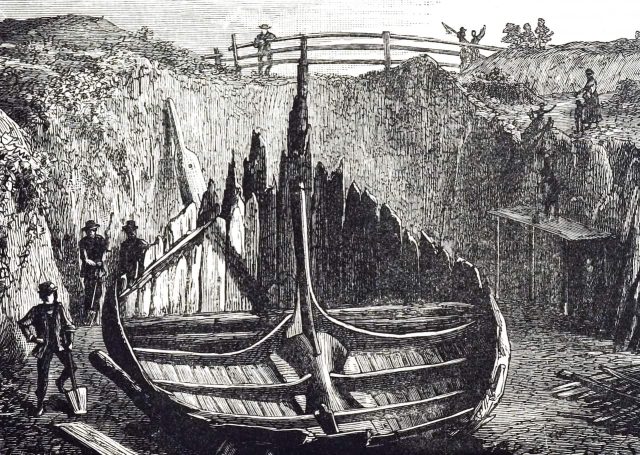The Vikings were seafaring people, who from the late 8th century to the late 11th century raided, pirated, traded, and settled across much of Europe.
They also voyaged as far afield as the Mediterranean, North Africa, Greenland, and what is now Newfoundland in Canada.
They were a force to be reckoned with and had a profound impact on early medieval history in Europe.
But while many associate the Viking Age with all-conquering male warriors, curators at Denmark’s National Museum say there was an incredibly powerful female position in Viking society known as the Völva.
A 19th-century engraving depicting a Viking burial ship found in Norway. Source: Getty / Universal History Archive / Universal Images Group
Little is known about the Völva — which means ‘staff bearer’ in Old Norse — but historians believe she was a kind of fortune-telling female shaman.
National Museum of Denmark curator Peter Pentz said the roots of the Völva probably date back centuries.
“Even the Romans explained that the Germanic tribes from the north, when their armies came down into the Mediterranean, they had a follower, a woman, an old woman who could foresee the outcome of a battle.
“And she will also be the one, when they took prisoners, who cut the throat of the prisoners.”
According to experts, the Völva were so powerful they left male raiders shaking in their boots — and even the king of the gods Odin sought the help of one.
There are numerous mentions of Viking sorceresses in old poems and sagas.
They probably had high status in Viking society, offering conjured visions of the future to whole settlements; some even informed Viking royalty.
But it was their ability to ‘sejd’ — a form of magic that could involve an out-of-body trance — that made them truly unique.
‘People were very frightened of her’
“The Völva had a very, very special role and people were very frightened of her,” said Mette Boritz, the editor of a new exhibition about the Völva at the National Museum of Denmark.
“Even guards and strong Vikings were afraid of the Völva. Of course you were afraid of a person that can speak with the spirits, and that can look into the future and maybe change something in that future.
“So, she had an extreme power in those days,” he added.
Visitors to the exhibition explore the otherworldly Völva’s Garden, before coming face-to-face with Ragnarök, the ‘Doom of the Gods’ and end of the world for both gods and men.
Fyrkat is a former Viking ring castle in Denmark, dating from around 980 AD. It likely served as barracks or a defensive stronghold. Source: Getty / Cavan Images
Few artefacts remain to cast light on the Völva’s mysterious history.
But experts believe a grave from around 980, discovered among the remains of Fyrkat ring fortress in Denmark, has all the hallmarks of a resting place for a sorceress.
“Viking hoards are usually bullion hoards, containing silver, silver clips, silver bars. Value, pure money value for buying, selling,” said Pentz.
“But this one, this hoard contains amulets, beads, which could also be interpreted as a kind of magic stuff, amulets, each bead having its meaning, its function. And there are hundreds of beads coming from all over the world.”
The Völvas and women in medieval society
Pentz says it’s likely just a romantic idea that females in Viking society had many of the same rights as males.
He says Viking society was much like any other in Europe at the time — dominated by men.
But that’s not the whole story.
“There were some rules in Viking society providing women with a little bit more privileged world than their sisters in the rest of Europe.”
“For instance, their access to divorce, their access to ownership, some of them even went to war with sword in hand.”
“So, it might be a romantic idea, but there’s a little, tiny bit of truth in it,” Pentz said.
The song of the Völvas
There’s no doubt that for hundreds of years, the Völvas had a special part to play in Viking society during rituals that began with a song to lure or attract the spirits.
The song had to be sung as beautifully as possible so the spirits would be pleased and therefore be more likely to help the Völva in her ritual.
Faroese singer-songwriter Eivør Pálsdóttir believes the song may have sounded like this:
The Völva would either sit on a high chair or she would be lifted up, so she would be able to see into another realm.
If the spirits were pleased with the song they would help the Völva in predicting the future or seeing the past.
But it could be dangerous, the people were afraid of the Völva and if her clan did not like her prophecies, she could be killed.
Spread of Christianity heralded downfall of the Völvas
As the famous Viking King Harald Bluetooth spread Christianity throughout his kingdom, the Völvas slowly lost their function.
By the Middle Ages, laws were introduced to suppress pagan rituals.
Today, there are still people who see themselves as Völva, sometimes to be found at markets in Scandinavia.
While the practice may have officially died out with the introduction of Christianity, it seems you can’t kill an idea.





